By Tanay Ved
Compiled by: TechFlow
Key Takeaways :
The reversal in the odds of an Ethereum ETF approval has driven a 25% increase in the price of ETH, as well as gains in tokens related to the Ethereum ecosystem.
Grayscale’s Ethereum Trust Fund (ETHE) discount to net asset value (NAV) narrowed from 50% a year ago to 1.28% at the time of ETF approval.
ETH ETFs not participating in staking may have an impact on ETH's supply dynamics, staking ecosystem, and network resilience.
introduction
In an unexpected turn of events, the U.S. Securities and Exchange Commission ( SEC ) has approved a spot exchange-traded fund ( ETF ) for the second-largest digital asset, ETH. On May 23, 19b-4 proposals from eight issuers were approved, including industry giants such as BlackRock, Fidelity, Bitwise, VanEck, and Grayscale. Just four months ago, we saw the end of a decade-long quest for a spot Bitcoin ETF, with 11 issuers participating in the race dubbed the “Cointucky Derby.” The launch was preceded by months of anticipation and subsequently attracted $12B in net inflows, making it the fastest-growing ETF launch in history.
However, things have changed for Ethereum. The security status of Ethereum and its Proof-of-Stake (PoS) consensus mechanism remains unclear, and the SEC has taken action against prominent industry players such as Coinbase and Consensys. Nonetheless, the odds of a spot Ethereum ETF approval have shifted from unlikely in January to a reality in May, capping off a critical week that marked an important turning point in the regulatory landscape for the digital asset industry. In this issue, we measure the market reaction and network impact following the SEC’s approval of a spot Ethereum ETF in the United States.
Market Reaction
With such a short window to price in this development, the market reacted quickly, with the increase in the probability of approval to 75% triggering an immediate reaction in the market price of ETH and other Ethereum ecosystem tokens. PEPE (+80%) is the largest meme on Ethereum, LDO (+44%) is the governance token of liquidity staking provider Lido, UNI (+44%) is the token of decentralized exchange (DEX) Uniswap, and provided the highest returns, while ETH rose (+27%).
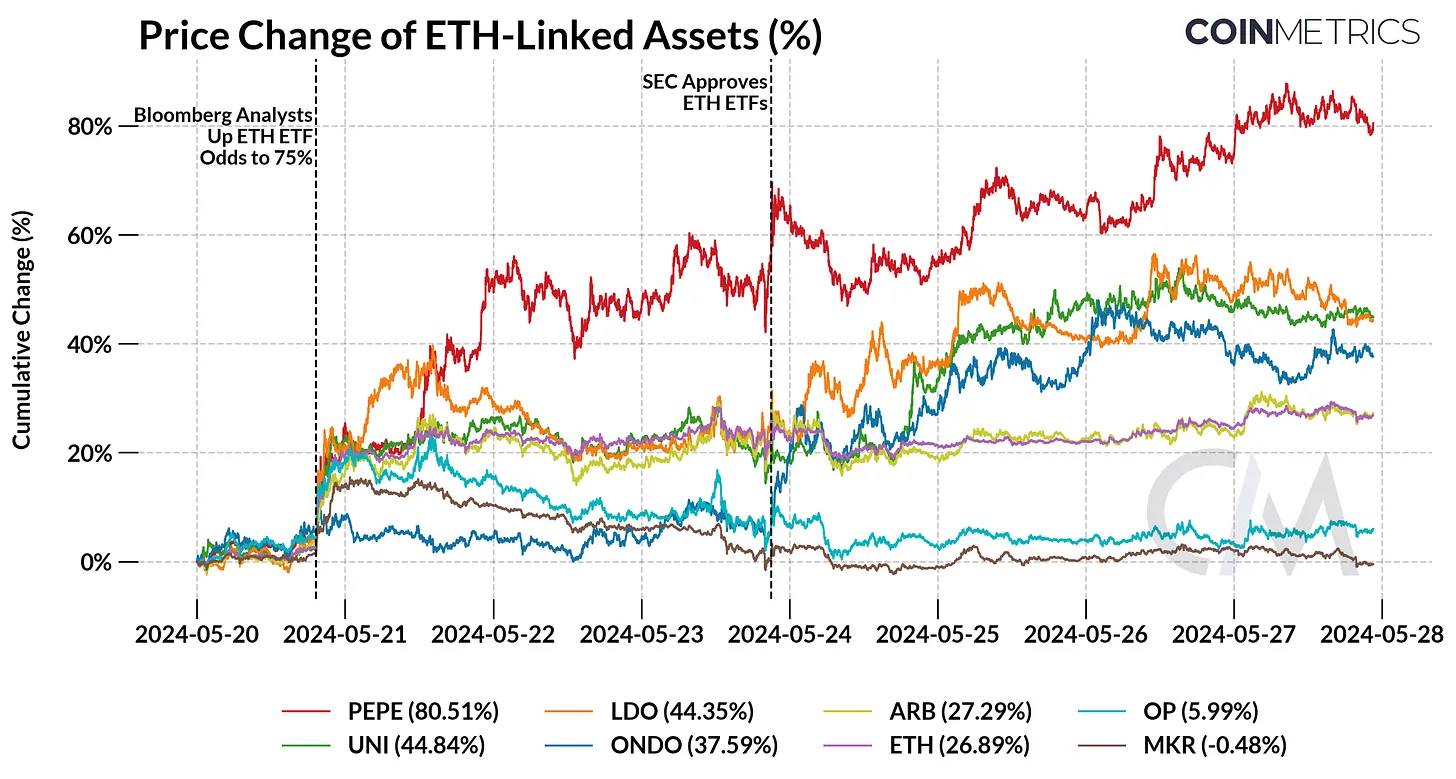
(Source: Coin Metrics Reference Rate)
Ethereum (ETH) has been in a downtrend relative to Bitcoin (BTC) (ETH/BTC ratio) since September 2022 , but this news provides it with a much-needed boost. Despite rising to 0.056 before the ETF approval, it needs to break through key resistance levels to resume the uptrend and make up for its underperformance relative to other large crypto assets such as BTC and SOL. While the approval of 19b-4 did not accelerate gains, the approval of the expected S-1 registration statement and the subsequent launch of the Ethereum ETF should serve as a strong driver of wider acceptance of ETH as an investable "commodity" and mainstream adoption of the Ethereum network.
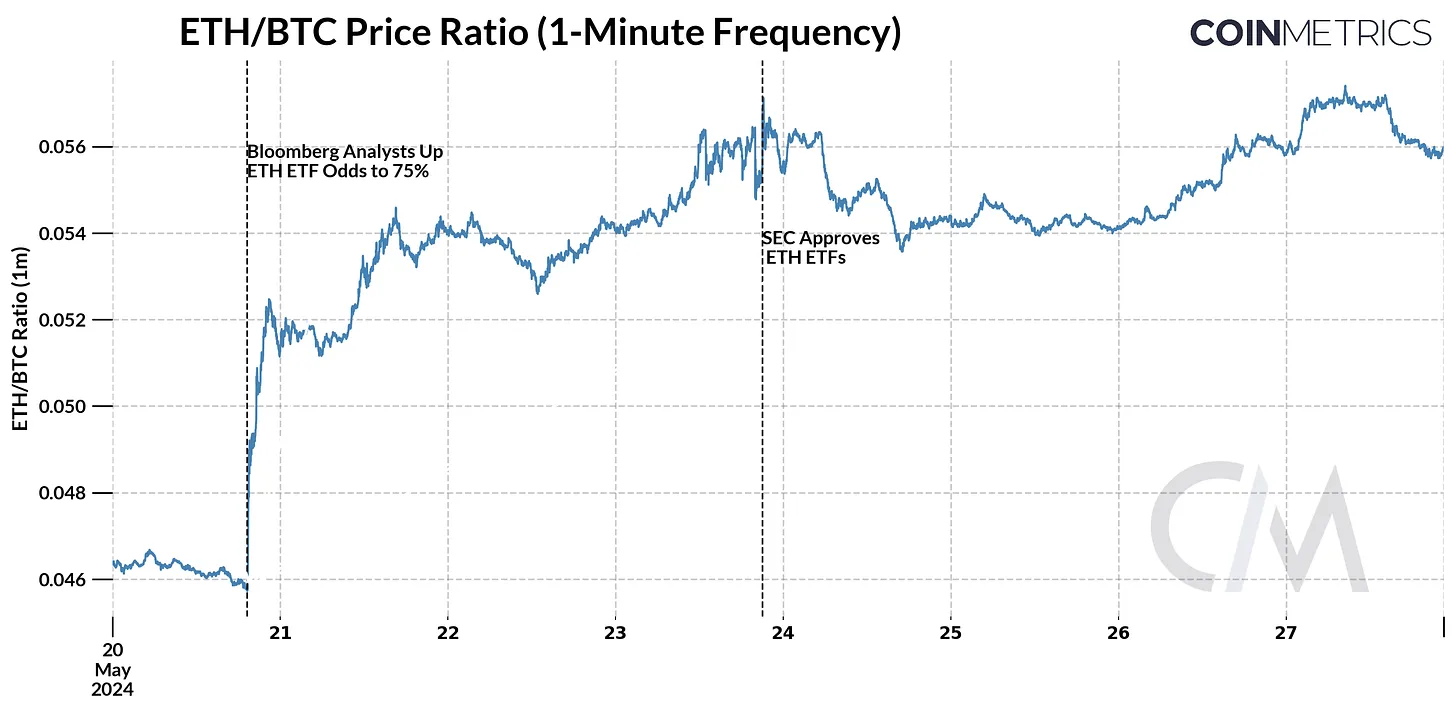
(Source: Coin Metrics Reference Rate)
Investor Sentiment and Market Positioning
Market sentiment for the approval of a spot Ethereum ETF is reflected in the narrowing discount of the Grayscale Ethereum Trust (ETHE) to its net asset value (NAV). Compared to a discount of about 50% a year ago, ETHE’s market price has narrowed to within 1.28% of its NAV, with a 20% reduction occurring in just 5 days.
While this is reminiscent of the Grayscale Bitcoin Trust (GBTC) before its conversion to an ETF in January, the faster pace of ETHE’s discount compression highlights that this change was unexpected by market participants. Nevertheless, investors have begun to strategically position themselves in anticipation of ETHE’s conversion to an exchange-traded product after its public offering.
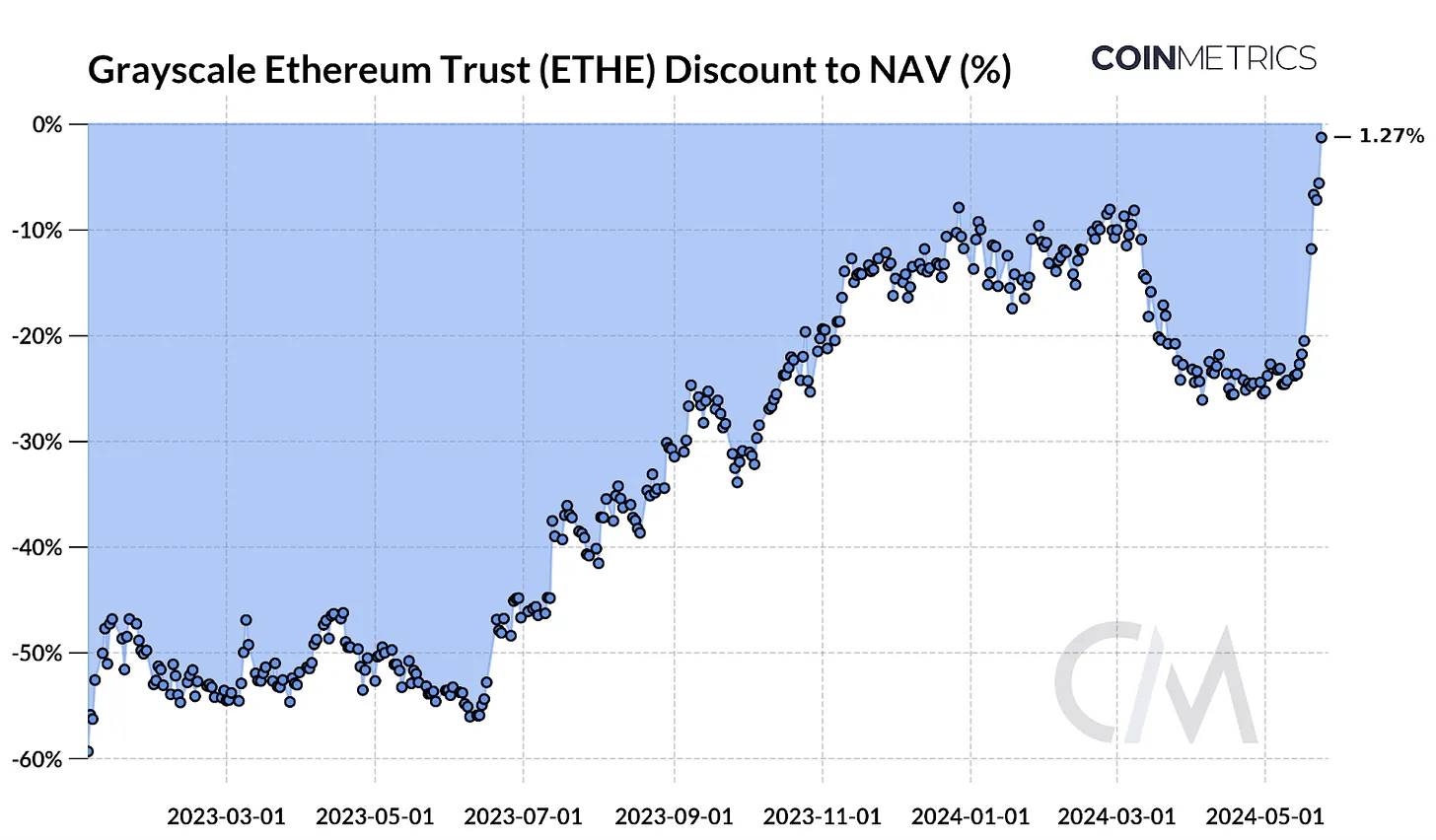
(Source: Coin Metrics Institutional Index, Grayscale)
Open interest (OI) for ETH futures contracts hit a record high of $13.8 billion, indicating an increase in speculation around an Ethereum ETF . While this value is still lower than the BTC open interest level before the launch of a spot Bitcoin ETF, the growth in the value of outstanding ETH futures contracts on Binance, EURUSD, and CME indicates more active activity from retail and institutional investors.
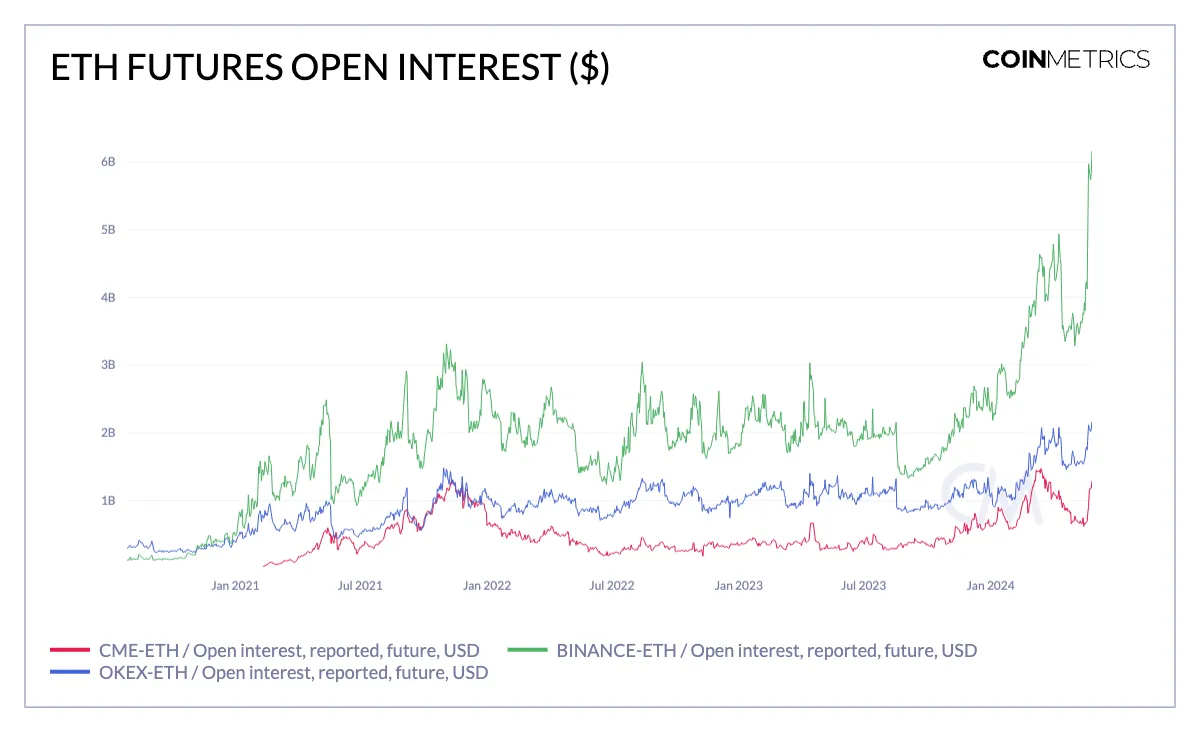
(Source: Coin Metrics market data)
How does the ETH ETF affect staking?
An important development regarding the approval of spot Ethereum ETFs is that they will not include staking functionality. Issuers will not be able to stake ETH, which could have potential implications for ETH’s supply dynamics, the health of the Ethereum consensus layer, and the entire staking ecosystem.
Impact on Ethereum supply dynamics
As the native asset of the Ethereum ecosystem, ETH is at the core of its operations and security. ETH can be used as a unit of account, a store of value, or collateral, on which a diversified economic system is built. This includes using ETH for staking to secure the network in the Proof of Stake (PoS) consensus mechanism, depositing ETH into smart contracts to support decentralized finance (DeFi) services, paying transaction fees, or keeping it in a user's account as an asset for investment and value storage.
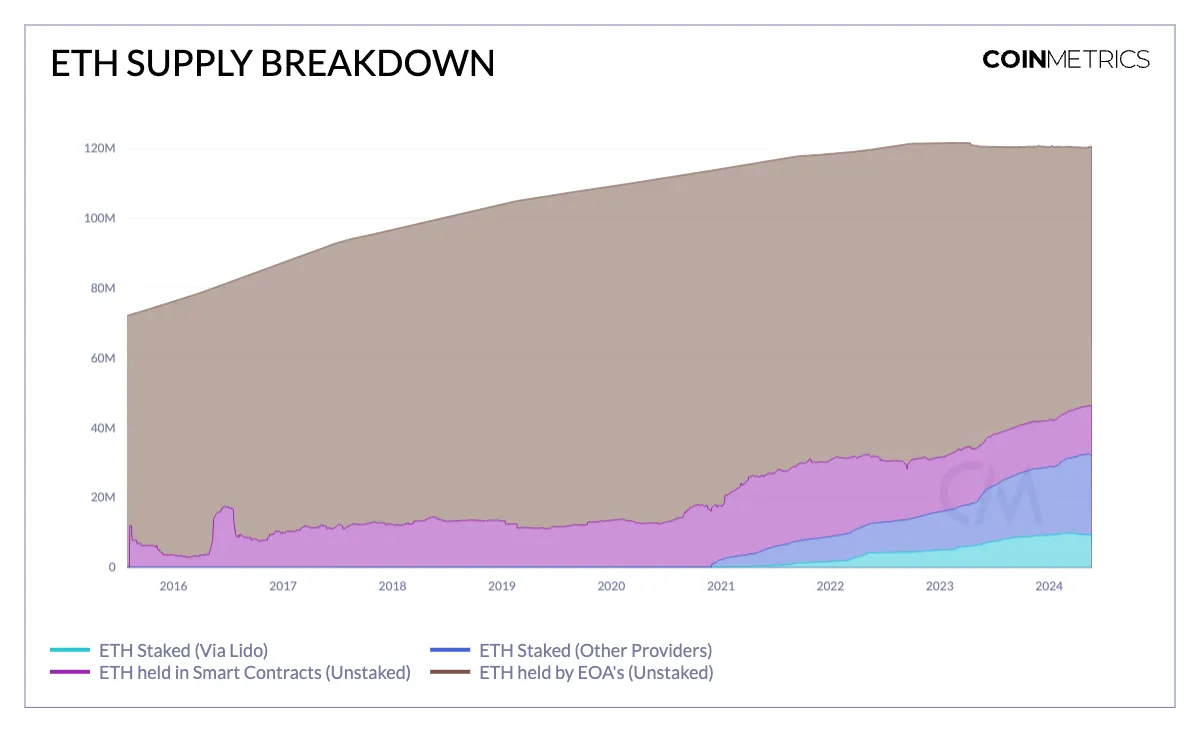
(Source: Coin Metrics network data)
Currently, of the total 120M ETH supply, 27% is staked in the consensus layer, 11% is held in smart contracts (unstaked), and 61% is held by external accounts (EOA). As ETF issuers absorb more circulating ETH, it is expected that most of the supply will be locked, which may reduce the available supply in the market. The reduction in circulating supply, coupled with strong demand, may increase the possibility of ETH price appreciation.
Impact on Ethereum Consensus Layer
Currently, 32 million ETH (27% of total supply) is staked on the Ethereum Beacon Chain through individual staking, staking pools such as Lido, or custodial staking providers such as Coinbase. However, the ratio of 27% staked to 73% unstaked is unlikely to change dramatically when excluding ETH ETF staking. Staking yield is a key component of the return of holding ETH. Therefore, excluding ETFs from staking may be beneficial to existing stakers because it prevents the dilution of staking returns that occurs when institutional capital enters the staking ecosystem.
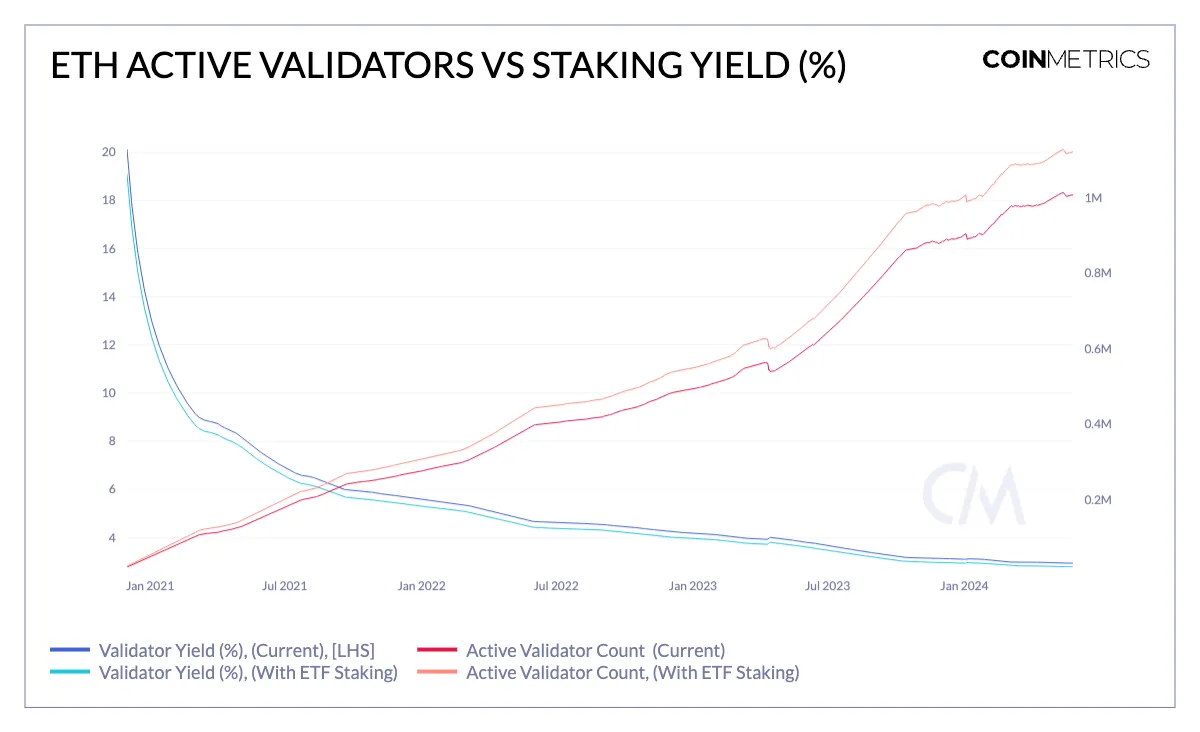
(Source: Coin Metrics network data)
The potential impact of consensus rewards (excluding tips and MEV) on validator returns can be seen in the figure above. Assuming an Ethereum ETF issuer acquires 10% of the ETH supply (approximately 12 million ETH) and stakes 30% of it, the number of active validators at the consensus layer will increase by 11.25%, from the current 1 million to 1.125 million. Due to the inverse relationship, more validators and staked ETH will cause the staker's annual percentage yield (APY) to decrease from approximately 2.9% to 2.7%. While this is not an exact measure, it illustrates the potential impact on staking yields if an ETF issuer stakes additional ETH.
It’s also important to consider that the maximum effective balance per validator (currently set to 32 ETH) will be increased to 2048 ETH in the upcoming Electra upgrade, which could change validator and network security dynamics.
In addition, the fact that ETH ETF does not include a staking function may have a positive impact on Ethereum's staking ratio and decentralization. Currently, with the rapid growth of the staking rate, Lido and Coinbase hold 28% and 13% of the staking ETH market share respectively. If institutional capital participates in staking, Coinbase, as the main ETF custodian, may become the main beneficiary of staking ETH, thereby exacerbating the risk of centralization.
These concerns have sparked discussions in the Ethereum community about adjusting the issuance rate of ETH to mitigate negative effects such as staking centralization, reduced competitiveness of independent stakers, and inflationary pressure faced by non-stakers. In the long run, it remains to be seen whether the SEC will allow Ethereum ETFs to be staked. However, by not staking ETH, ETFs can help maintain a balanced staking ratio to a certain extent and promote a healthier staking distribution.
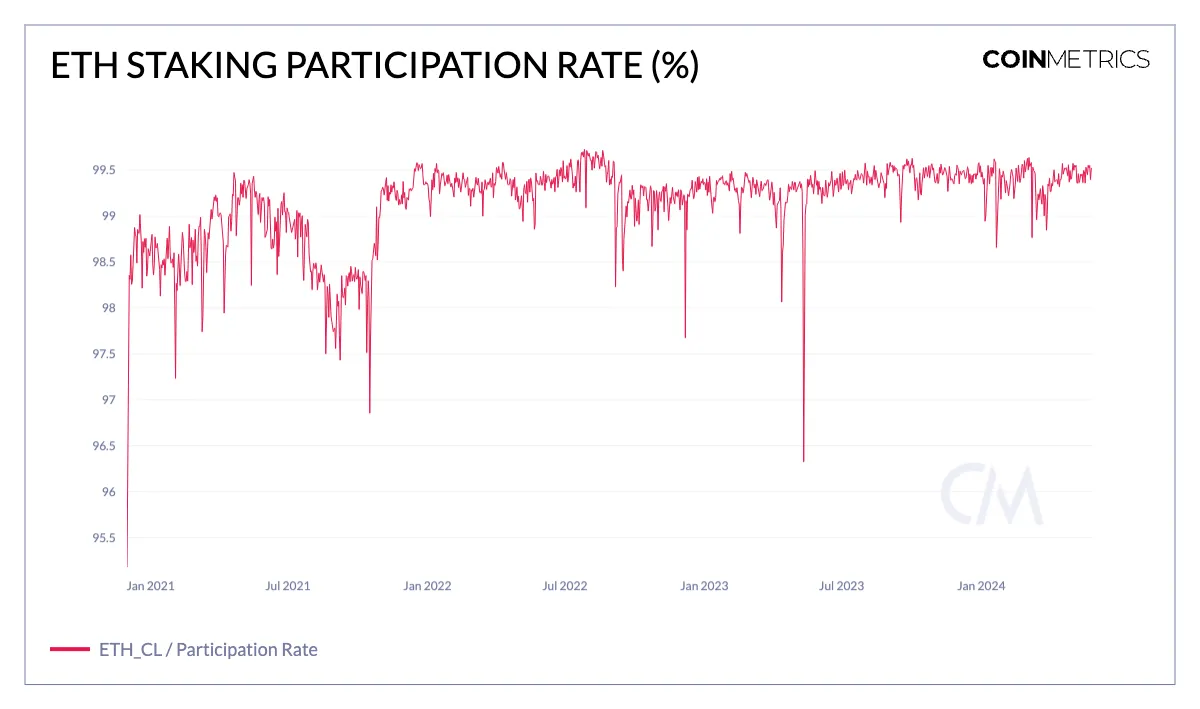
(Source: Coin Metrics network data)
The participation rate of the Ethereum consensus layer is 99.5%, indicating that most validators maintain network security by voting and proposing blocks. This also means that staking rewards are being distributed to a larger pool of validators, ensuring decentralization. In the future, the proposed changes in issuance and effective balances, coupled with the SEC's stance on ETFs that include staking, will shape the future of the Ethereum staking ecosystem.
in conclusion
This past week marked a major shift in the U.S. digital asset regulatory landscape, including the passage of the FIT21 crypto market structure bill and the approval of an Ethereum ETF. However, many questions remain unanswered: Can an Ethereum ETF garner comparable investment flows to a Bitcoin ETF? How will staking dynamics evolve in the context of these developments? And what are the broader implications for other crypto markets? While this remains to be seen, regulatory clarity and greater accessibility are expected to attract broader demand into ETH and its ecosystem.
Network Data Insights
Summary Highlights
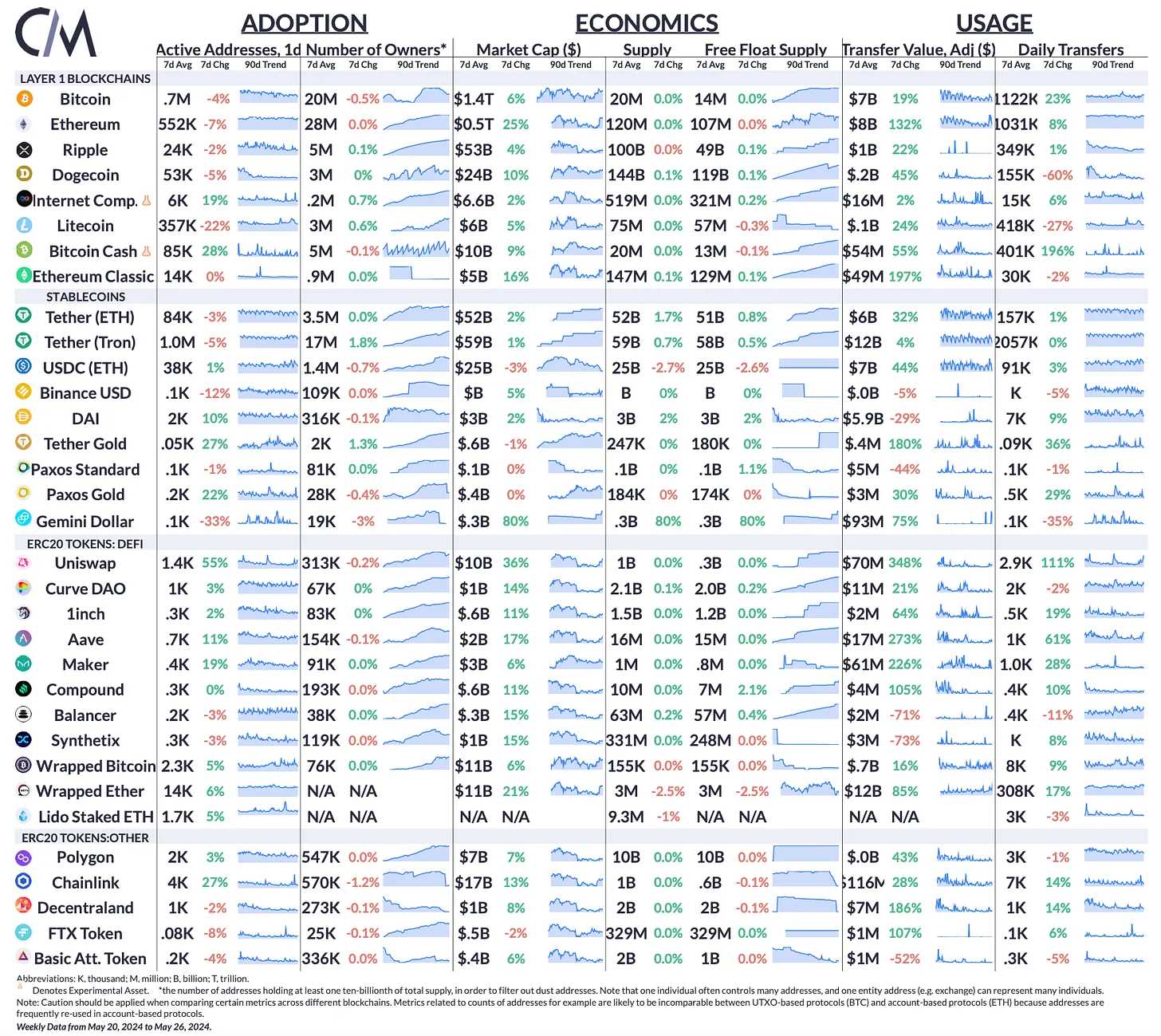
(Source: Coin Metrics network data)
Ethereum (ETH) market capitalization has risen 25% over the past week, while adjusted transfer value has increased 132% to $8 billion. With the approval of an ETH ETF, some ERC-20 tokens have seen an uptick in activity and valuations.







